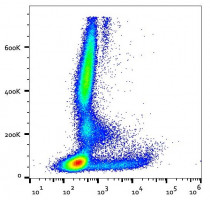ARG54264
anti-CD1c antibody [L161] (PE)
anti-CD1c antibody [L161] (PE) for Flow cytometry and Human
Immune System antibody
Overview
| Product Description | PE-conjugated Mouse Monoclonal antibody [L161] recognizes CD1c |
|---|---|
| Tested Reactivity | Hu |
| Tested Application | FACS |
| Specificity | The clone L161 recognizes CD1c, (R7), a 43 kDa type I glycoprotein associated with beta2-microglobulin. It is expressed on cortical thymocytes (strongly), Langerhans cells, dendritic cells, B and some T cells. |
| Host | Mouse |
| Clonality | Monoclonal |
| Clone | L161 |
| Isotype | IgG1 |
| Target Name | CD1c |
| Antigen Species | Human |
| Immunogen | human thymocytes |
| Conjugation | PE |
| Alternate Names | R7; CD antigen CD1c; CD1A; CD1; T-cell surface glycoprotein CD1c; BDCA1 |
Application Instructions
| Application Suggestion |
|
||||
|---|---|---|---|---|---|
| Application Note | * The dilutions indicate recommended starting dilutions and the optimal dilutions or concentrations should be determined by the scientist. |
Properties
| Form | Liquid |
|---|---|
| Purification Note | The purified antibody is conjugated with R-Phycoerythrin (PE) under optimum conditions. The conjugate is purified by size-exclusion chromatography and adjusted for direct use. No reconstitution is necessary. |
| Buffer | PBS, 15 mM Sodium azide and 0.2% (w/v) high-grade protease free BSA |
| Preservative | 15 mM Sodium azide |
| Stabilizer | 0.2% (w/v) high-grade protease free BSA |
| Storage Instruction | Aliquot and store in the dark at 2-8°C. Keep protected from prolonged exposure to light. Avoid repeated freeze/thaw cycles. Suggest spin the vial prior to opening. The antibody solution should be gently mixed before use. |
| Note | For laboratory research only, not for drug, diagnostic or other use. |
Bioinformation
| Database Links | |
|---|---|
| Gene Symbol | CD1C |
| Gene Full Name | CD1c molecule |
| Background | CD1c (also known as R7 or BDCA1) together with CD1a and b, belongs to group 1 of CD1 antigens. These non-classical MHC-like glycoproteins serve as antigen-presenting molecules for a subset of T cells that responds to specific lipids and glycolipids found in the cell walls of bacterial pathogens or self-glycolipid antigens such as gangliosides, and they have also roles in antiviral immunity. The trafficking routes of the particular CD1 types differ and correspond to their ability to bind and present different groups of antigens. CD1c is unique in its ability to present e.g. mycobacterial phosphoketides and polyisoprenoids. CD1c is the only CD1 isoform that has been shown to interact both with alpha/beta and gamma/delta T cells. |
| Function | Antigen-presenting protein that binds self and non-self lipid and glycolipid antigens and presents them to T-cell receptors on natural killer T-cells. [UniProt] |
| Research Area | Immune System antibody |
| Calculated MW | 38 kDa |
Images (1) Click the Picture to Zoom In






